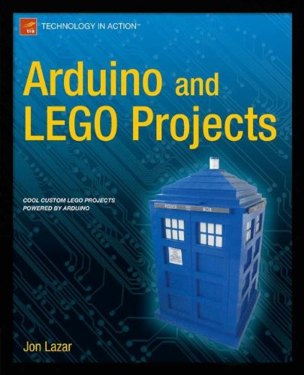| Arduino and LEGO Projects |
Author: Jon Lazar
Both Arduino and Lego are popular among makers and for producing very rapid prototypes so what could be more reasonable than a book that combines the two? However, you need to be very clear as to what sort of materials the book is going to make use of. Lego has its own hardware controller in the form of the NXT Brick and it has lots of sensors and motors that can be used to create dynamic models and mechanisms. If you are expecting this book to be about using this sort of Lego with the Arduino then you are going to be disappointed. This book is much more about taking standard Lego components - mostly bricks - and putting them together with an Arduino and a standard set of Arduino parts such as servos. It makes use of the Lego purely as a mechanical construction kit and leaves all of the sensors and actuators to the non-Lego world. The book starts off with a look at the Arduino and on page 2 you will see a picture of the NXT Brick, which might confuse the browsing prospective reader that the book covers this sort of hardware - it doesn't. The chapter then goes on to a first Arduino program which is as nearly always a matter of flashing an onboard LED. The explanation of the program is only suitable for someone who already programs and not really for the complete beginner. Straight after this most basic of example the book moves on to connecting and using a servo with no explanation of what a server is or how it is controlled. You simply make up an off-the-shelf motor board and start to program it. The aim is to build an example of the "ultimate machine" - one that switches itself off when you switch it on using a mechanical actuator. This is where the book shows its true colors. After a very brief explanation of the technology, we get into Lego bricks in a big way with a detailed explanation of how to build the device. This would be a lot better if the photos of the build were of a higher quality. They are black-and-white and very muddy - more like photocopies of originals. Most of Chapter 1 is devoted to a detailed explanation of the Lego build. Chapter 2 is about using sensors. Given it is called "Using Sensors with the Android" you would be forgiven for thinking that this isn't an Arduino-based project but one that uses a mobile phone. This misleading title refers to the fact that you are going to build the mascot of the Android phone - yes the little green guy. To do this you make use of an off-the-shelf ultrasonic distance measuring sensor. As before the details of the technical build are a bit on the thin side, especially so if you are a beginner, and very little of the principles are discussed. Then we move on to the building of the bricks and, yes you guessed it, the detail is overflowing. Lots of muddy and difficult-to-see pictures but a complete, virtually step-by-step, explanation of which bricks go where.
The remaining chapters follow the same basic outline of introducing some bit of technology at a very superficial level and then providing a detailed build of a Lego model. Chapter 3 is about a Twitter pet which uses an internet board to connect to Twitter. Chapter 4 uses RFID to create a "crystal ball" that reacts to a wand. Chapter 5 is perhaps the one that will attract the casual reader as it is about build a Dr Who Tardis complete with lights and sound effects. Chapter 6 moves into the world of Lego trains and builds a controller in the form of a platform. The final chapter explains how to build a light sensitive jewelry box which has a rotating ornament. This is a book you are going to love or hate. The readers who are going to hate it are the ones expecting it to be about teaching them the principles of the Arduino, how to program or how to work with electronics. This is not what the book is about. It isn't strong on teaching you techniques or deep principles. You will find out a lot about how to build Lego models that look good using ideas like S.N.O.T (Studs Not On Top) but you won't learn a great deal about Arduino programming or its hardware. This really is a project book pure and simple and it should be called something like "Seven Arduino-based Lego models". If you just want an ideas book that will take you thought the details of how to construct things then you might like this boo, but be warned many of the fine details of wiring up the electronics are left to you to to extract from the poor quality photos or from the instructions that come with the components. This probably isn't a book for the complete programming or electronics beginner - but you don't have to be an expert either. Overall, this isn't a book I can recommend to a wide audience and even if you fit the specification of wanting some models to build there are serious reservations about the quality of the presentation.
|
|||
| Last Updated ( Friday, 10 January 2014 ) |


